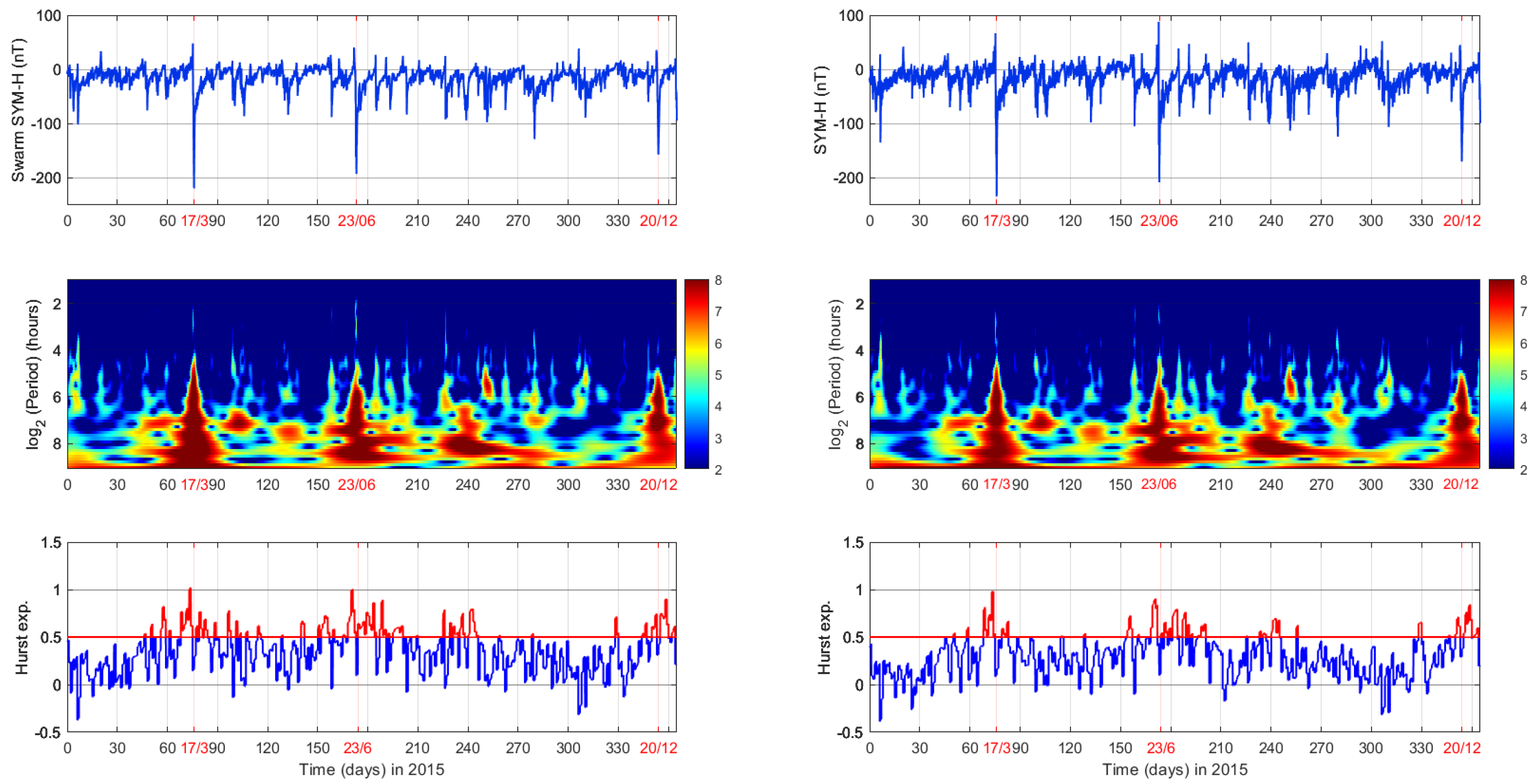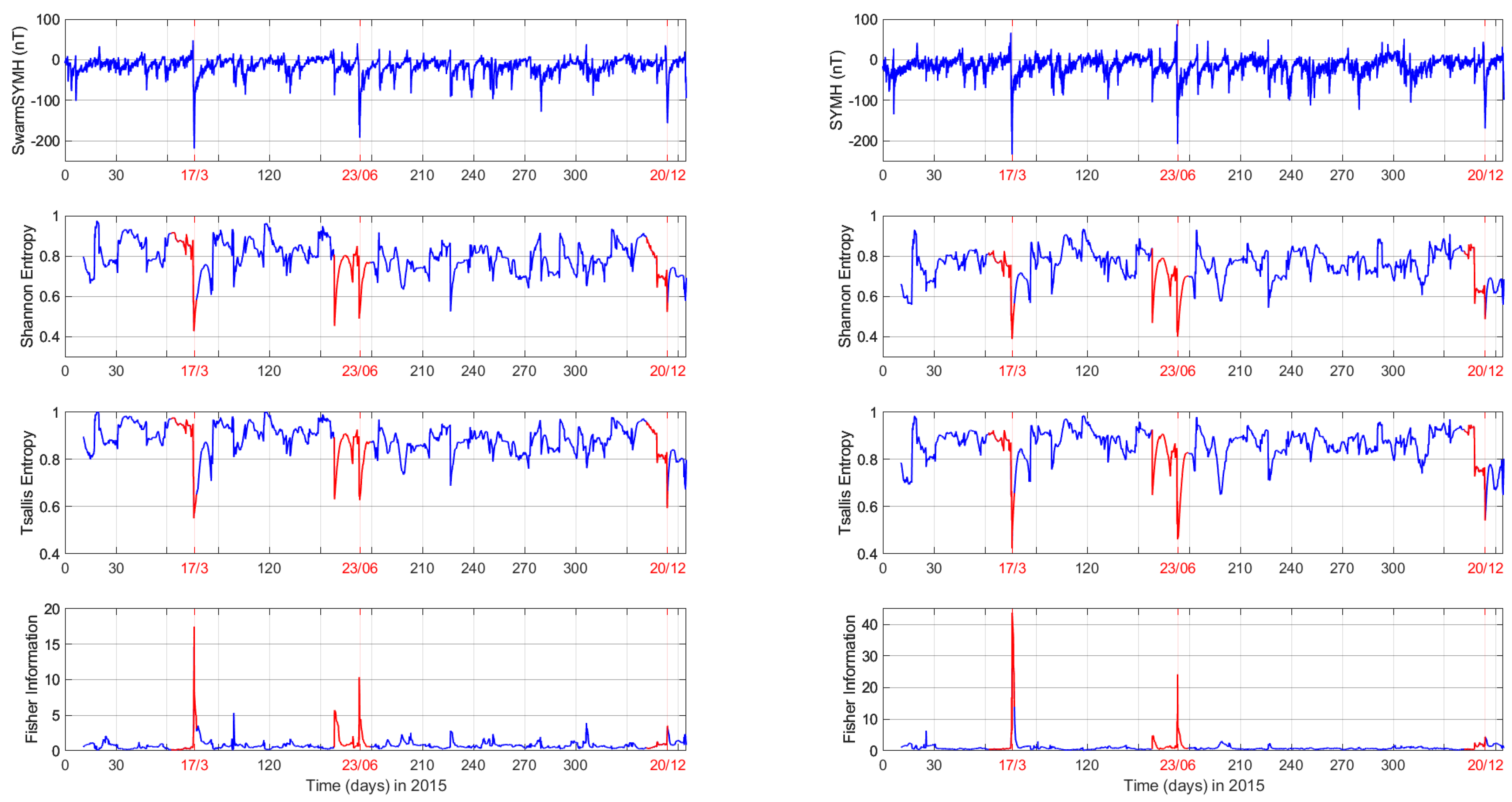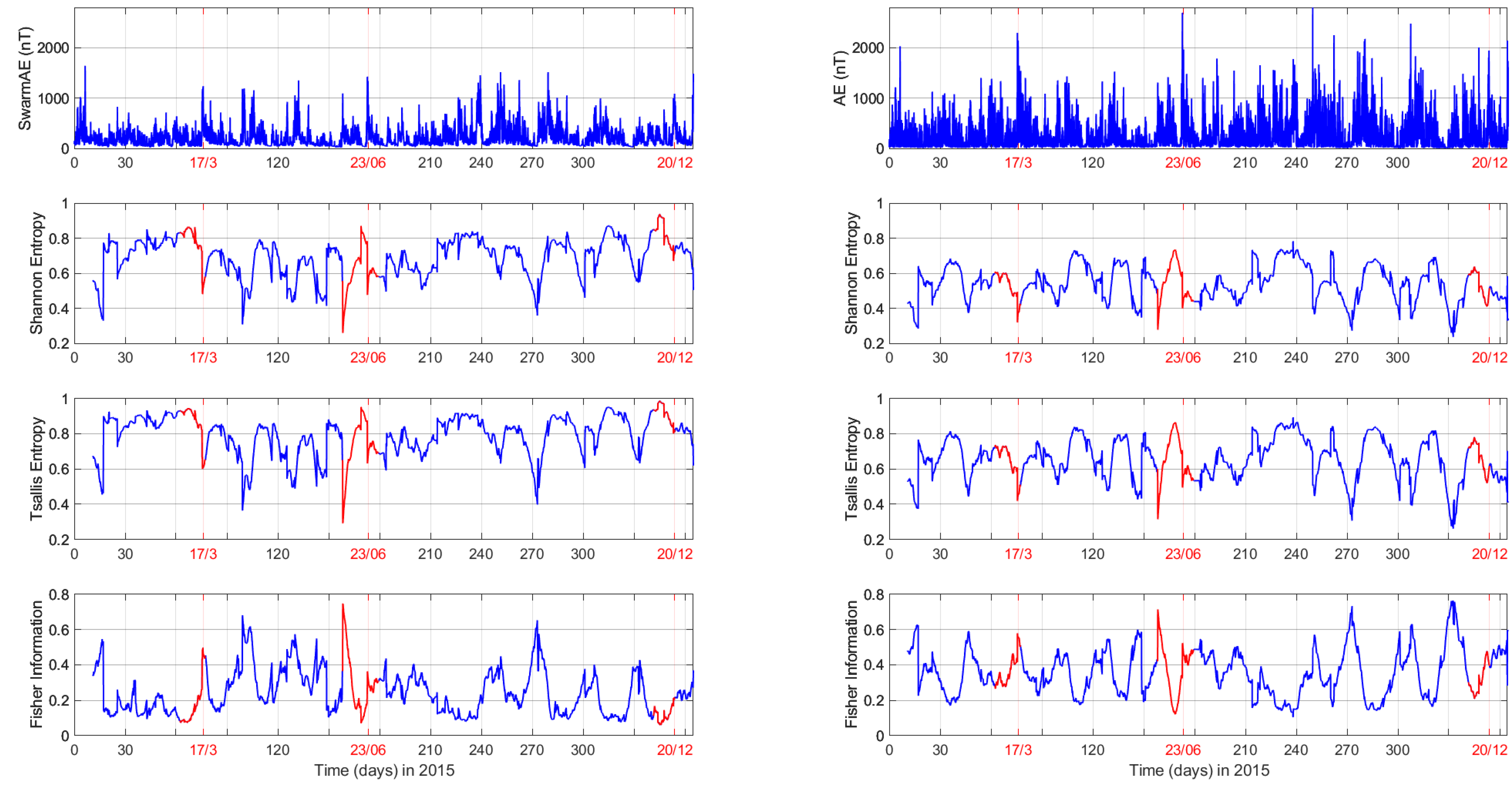Investigation of Dynamical Complexity in Swarm-Derived Geomagnetic Activity Indices Using Information Theory
Abstract
1. Introduction
2. Data Description
2.1. Swarm-derived SYM-H Index
- Extract Bpar Field Series from MAG_LR (1 Hz) product
- Subtract CHAOS-7 [36] Internal Field Model
- Remove obvious outliers
- Remove values that lie above or below in Magnetic Latitude
- Apply a non-overlapping, moving average scheme on the time series, with a window of 60 s, so that the series are set to a 1-min time resolution, effectively filling up some of the smaller gaps
- Merge Swarm A and Swarm B time series, in a joint 1-min resolution data set
- Interpolate the remaining data gaps, using a simple linear scheme, to produce a complete time series
- Apply a low-pass Chebyshev Type I filter with a cutoff period of 4 h, to filter out some of the small perturbations in the signal that arise from the fast motion of the satellites
- Apply a linear transform to get the Swarm Index:
2.2. Swarm-Derived AE Index
- Extract Total Magnetic Field Series from MAG_LR (1 Hz) product
- Subtract CHAOS-7 [36] Internal Field Model
- Remove obvious outliers
- Keep only measurements between and (and correspondingly to ) in Magnetic Latitude
- Apply a non-overlapping, moving average scheme on the time series, with a window of 60 s, so that the series are set to a 1-min time resolution, effectively filling up some of the smaller gaps
- Merge Swarm A and Swarm B time series in a joint 1-min resolution data set
- Interpolate the remaining data gaps, using a simple linear scheme, to produce a complete time series
- Apply a low-pass Chebyshev Type I filter with a cutoff period of 2.6 h, to filter out some of the small perturbations in the signal that arise from the fast motion of the satellites
- Apply a linear transform to get the Swarm Index:
3. Overview of Methods
3.1. Hurst Exponent
- : fractional Gaussian noise (fGn)
- : fractional Brownian motion (fBm)
3.2. Entropy Measures
4. Results
5. Discussion and Conclusions
Author Contributions
Funding
Institutional Review Board Statement
Informed Consent Statement
Data Availability Statement
Acknowledgments
Conflicts of Interest
References
- Friis-Christensen, E.; Lühr, H.; Hulot, G. Swarm: A constellation to study the Earth’s magnetic field. Earth Planets Space 2006, 58, 351–358. [Google Scholar] [CrossRef]
- Papadimitriou, C.; Balasis, G.; Boutsi, A.Z.; Antonopoulou, A.; Moutsiana, G.; Daglis, I.A.; Giannakis, O.; De Michelis, P.; Consolini, G.; Gjerloev, J.; et al. Swarm-derived indices of geomagnetic activity. J. Geophys. Res. Space Phys. 2021, 126, e2021JA029394. [Google Scholar] [CrossRef]
- Balasis, G.; Papadimitriou, C.; Boutsi, A.Z. Ionospheric response to solar and interplanetary disturbances: A Swarm perspective. Phil. Trans. R. Soc. A 2019, 377, 20180098. [Google Scholar] [CrossRef] [PubMed]
- Johnson, J.R.; Wing, S. A solar cycle dependence of nonlinearity in magnetospheric activity. J. Geophys. Res. 2005, 110, A04211. [Google Scholar] [CrossRef]
- Wing, S.; Johnson, J.R.; Turner, D.L.; Ukhorskiy, A.Y.; Boyd, A.J. Untangling the solar wind and magnetospheric drivers of the radiation belt electrons. J. Geophys. Res. Space Phys. 2022, 127, e2021JA030246. [Google Scholar] [CrossRef]
- Baker, D.N.; Klimas, A.J.; McPherron, R.L.; Büchner, J. The evolution from weak to strong geomagnetic activity: An interpretation in terms of deterministic chaos. Geophys. Res. Lett. 1990, 17, 41–44. [Google Scholar] [CrossRef]
- Tsurutani, B.T.; Sugiura, M.; Iyemori, T.; Goldstein, B.E.; Gonzalez, W.D.; Akasofu, S.-I.; Smith, E.J. The nonlinear response of AE to the IMF BS driver: A spectral break at 5 hours. Geophys. Res. Lett. 1990, 17, 279–282. [Google Scholar] [CrossRef]
- Vassiliadis, D.V.; Sharma, A.S.; Eastman, T.E.; Papadopoulos, K. Low-dimensional chaos in magnetospheric activity from AE time series. Geophys. Res. Lett. 1990, 17, 1841–1844. [Google Scholar] [CrossRef]
- Sharma, A.S.; Vassiliadis, D.V.; Papadopoulos, K. Reconstruction of low-dimensional magnetospheric dynamics by singular spectrum analysis. Geophys. Res. Lett. 1993, 20, 335. [Google Scholar] [CrossRef]
- Sitnov, M.I.; Sharma, A.S.; Papadopoulos, K.; Vassiliadis, D. Modeling substorm dynamics of the magnetosphere: From self-organization and self-organized criticality to nonequilibrium phase transitions. Phys. Rev. E 2001, 65, 16116. [Google Scholar] [CrossRef]
- Consolini, G.; De Michelis, P.; Tozzi, R. On the Earth’s magnetospheric dynamics: Nonequilibrium evolution and the fluctuation theorem. J. Geophys. Res. Space Phys. 2008, 113, A08222. [Google Scholar] [CrossRef]
- Balasis, G.; Daglis, I.A.; Papadimitriou, C.; Kalimeri, M.; Anastasiadis, A.; Eftaxias, K. Investigating dynamical complexity in the magnetosphere using various entropy measures. J. Geophys. Res. Space Phys. 2009, 114, A00D06. [Google Scholar] [CrossRef]
- Balasis, G.; Donner, R.V.; Potirakis, S.M.; Runge, J.; Papadimitriou, C.; Daglis, I.A.; Eftaxias, K.; Kurths, J. Statistical mechanics and information-theoretic perspectives on complexity in the earth system. Entropy 2013, 15, 4844–4888. [Google Scholar] [CrossRef]
- Wing, S.; Johnson, J.R.; Camporeale, E.; Reeves, G.D. Information theoretical approach to discovering solar wind drivers of the outer radiation belt. J. Geophys. Res. Space Phys. 2016, 121, 9378–9399. [Google Scholar] [CrossRef]
- Donner, R.V.; Stolbova, V.; Balasis, G.; Donges, J.F.; Georgiou, M.; Potirakis, S.M.; Kurths, J. Temporal organization of magnetospheric fluctuations unveiled by recurrence patterns in the Dst index. Chaos 2018, 28, 085716. [Google Scholar] [CrossRef]
- Donner, R.V.; Balasis, G.; Stolbova, V.; Georgiou, M.; Wiedermann, M.; Kurths, J. Recurrence based quantification of dynamical complexity in the Earth’s magnetosphere at geospace storm timescales. J. Geophys. Res. Space Phys. 2019, 124, 90–108. [Google Scholar] [CrossRef]
- Johnson, J.R.; Wing, S.; Camporeale, E. Transfer entropy and cumulant-based cost as measures of nonlinear causal relationships in space plasmas: Applications to Dst. Ann. Geophys. 2018, 36, 945–952. [Google Scholar] [CrossRef]
- Runge, J.; Balasis, G.; Daglis, I.A.; Papadimitriou, C.; Donner, R.V. Common solar wind drivers behind magnetic storm–magnetospheric substorm dependency. Sci. Rep. 2018, 8, 1–10. [Google Scholar] [CrossRef]
- Stumpo, M.; Consolini, G.; Alberti, T.; Quattrociocchi, V. Measuring Information Coupling between the Solar Wind and the Magnetosphere–Ionosphere System. Entropy 2020, 22, 276. [Google Scholar] [CrossRef]
- Manshour, P.; Balasis, G.; Consolini, G.; Papadimitriou, C.; Paluš, M. Causality and Information Transfer Between the Solar Wind and the Magnetosphere–Ionosphere System. Entropy 2021, 23, 390. [Google Scholar] [CrossRef]
- Osmane, A.; Savola, M.; Kilpua, E.; Koskinen, H.; Borovsky, J.E.; Kalliokoski, M. Quantifying the non-linear dependence of energetic electron fluxes in the Earth’s radiation belts with radial diffusion drivers. Ann. Geophys. 2022, 40, 37–53. [Google Scholar] [CrossRef]
- Balasis, G.; Papadimitriou, C.; Boutsi, A.Z.; Daglis, I.A.; Giannakis, O.; Anastasiadis, A.; De Michelis, P.; Consolini, G. Dynamical complexity in Swarm electron density time series using Block entropy. Europhys. Lett. 2020, 131, 69001. [Google Scholar] [CrossRef]
- De Michelis, P.; Pignalberi, A.; Consolini, G.; Coco, I.; Tozzi, R.; Pezzopane, M.; Giannattasio, F.; Balasis, G. On the 2015 St. Patrick’s Storm Turbulent State of the Ionosphere: Hints From the Swarm Mission. J. Geophys. Res. Space Phys. 2020, 125, e2020JA027934. [Google Scholar] [CrossRef]
- De Michelis, P.; Consolini, G.; Pignalberi, A.; Tozzi, R.; Coco, I.; Giannattasio, F.; Pezzopane, M.; Balasis, G. Looking for a proxy of the ionospheric turbulence with Swarm data. Sci. Rep. 2021, 11, 6183. [Google Scholar] [CrossRef]
- Papadimitriou, C.; Balasis, G.; Boutsi, A.Z.; Daglis, I.A.; Giannakis, O.; Anastasiadis, A.; De Michelis, P.; Consolini, G. Dynamical Complexity of the 2015 St. Patrick’s Day Magnetic Storm at Swarm Altitudes Using Entropy Measures. Entropy 2020, 22, 574. [Google Scholar] [CrossRef]
- Consolini, G.; Tozzi, R.; De Michelis, P.; Coco, I.; Giannattasio, F.; Pezzopane, F.; Marcucci, M.F.; Balasis, G. High-latitude polar pattern of ionospheric electron density: Scaling features and IMF dependence. J. Atmos.-Sol.-Terr. Phys. 2021, 217, 105531. [Google Scholar] [CrossRef]
- Poduval, B.; Pitman, K.M.; Verkhoglyadova, O.; Wintoft, P. Editorial: Applications of statistical methods and machine learning in the space sciences. Front. Astron. Space Sci. 2023, 10, 5–9. [Google Scholar] [CrossRef]
- Delzanno, G.L.; Borovsky, J.E. The Need for a System Science Approach to Global Magnetospheric Models. Front. Astron. Space Sci. 2022, 9, 10–16. [Google Scholar] [CrossRef]
- Telloni, D. Statistical Methods Applied to Space Weather Science. Front. Astron. Space Sci. 2022, 9, 154–160. [Google Scholar] [CrossRef]
- Verkhoglyadova, O.; Meng, X.; Kosberg, J. Understanding Large-Scale Structure in Global Ionospheric Maps with Visual and Statistical Analyses. Front. Astron. Space Sci. 2022, 9, 78–81. [Google Scholar] [CrossRef]
- Dungey, J.W. Interplanetary magnetic field and the auroral zones. Phys. Rev. Lett. 1961, 6, 47–48. [Google Scholar] [CrossRef]
- Bergin, A.; Chapman, S.; Gjerloev, J. AE, Dst and their SuperMAG Counterparts: The effect of improved spatial resolution in geomagnetic indices. J. Geophys. Res. Space Phys. 2020, 125, e2020JA027828. [Google Scholar] [CrossRef]
- Balasis, G.; Daglis, I.A.; Contoyiannis, Y.; Potirakis, S.M.; Papadimitriou, C.; Melis, N.S.; GIannakis, O.; Papaioannou, A.; Anastasiadis, A.; Kontoes, C. Observation of intermittency-induced critical dynamics in geomagnetic field time series prior to the intense magnetic storms of March, June, and December 2015. J. Geophys. Res. Space Phys. 2018, 123, 4594–4613. [Google Scholar] [CrossRef]
- Tozzi, R.; De Michelis, P.; Coco, I.; Giannattasio, F. A preliminary risk assessment of geomagnetically induced currents over the Italian territory. Space Weather 2019, 17, 46–58. [Google Scholar] [CrossRef]
- Boutsi, A.Z.; Balasis, G.; Dimitrakoudis, S.; Daglis, I.A.; Tsinganos, K.; Papadimitriou, C.; Giannakis, O. Investigation of the geomagnetically induced current index levels in the Mediterranean region during the strongest magnetic storms of solar cycle 24. Space Weather 2023, 21, e2022SW003122. [Google Scholar] [CrossRef]
- Finlay, C.C.; Kloss, C.; Olsen, N.; Hammer, M.; Toeffner-Clausen, L.; Grayver, A.; Kuvshinov, A. The CHAOS-7 geomagnetic field model and observed changes in the South Atlantic Anomaly. Earth Planets Space 2020, 72, 156. [Google Scholar] [CrossRef]
- Emmert, J.T.; Richmond, A.D.; Drob, D.P. A computationally compact representation of Magnetic-Apex and Quasi-Dipole coordinates with smooth base vectors. J. Geophys. Res. 2010, 115, A08322. [Google Scholar] [CrossRef]
- Balasis, G.; Daglis, I.; Kapiris, P.; Mandea, M.; Vassiliadis, D.; Eftaxias, K. From pre-storm activity to magnetic storms: A transition described in terms of fractal dynamics. Ann. Geophys. 2006, 24, 3557–3567. [Google Scholar] [CrossRef]
- Pitsis, V.; Balasis, G.; Daglis, I.A.; Vassiliadis, D.; Boutsi, A.Z. Power-law dependence of the wavelet spectrum of ground magnetic variations during magnetic storms. Adv. Space Res. 2023, 71, 2288–2298. [Google Scholar] [CrossRef]
- Heneghan, C.; McDarby, G. Establishing the relation between detrended fluctuation analysis and power spectral density analysis for stochastic processes. Phys. Rev. E. 2000, 62, 6103–6110. [Google Scholar] [CrossRef]
- Alberti, T.; Consolini, G.; De Michelis, P. Complexity of geomagnetic index in the last two solar cycles. J. Atmos. Solar Terr. Phys. 2021, 217, 105583. [Google Scholar] [CrossRef]
- Kantelhardt, J.W.; Zschiegner, S.A.; Koscielny-Bunde, E.; Havlin, S.; Bunde, A.; Stanley, H.E. Multifractal detrended fluctuation analysis of nonstationary time series. Phys. A Stat. Mech. Its Appl. 2002, 316, 87–114. [Google Scholar] [CrossRef]
- Agarwal, S.; Del Sordo, F.; Wettlaufer, J.S. Exoplanetary detection by multifractal spectral analysis. Astron. J. 2017, 153, 12. [Google Scholar] [CrossRef]
- Balasis, G.; Daglis, I.A.; Papadimitriou, C.; Kalimeri, M.; Anastasiadis, A.; Eftaxias, K. Dynamical complexity in Dst time series using non-extensive Tsallis entropy. Geophys. Res. Lett. 2008, 35, L14102. [Google Scholar] [CrossRef]
- Shannon, C.E. A mathematical theory of communication. Bell Syst. Tech. J. 1948, 27, 379–423. [Google Scholar] [CrossRef]
- Tsallis, C. Introduction to Nonextensive Statistical Mechanics: Approaching a Complex World; Springer: New York, NY, USA, 2009; Volume 1. [Google Scholar]
- Balasis, G.; Daglis, I.A.; Papadimitriou, C.; Anastasiadis, A.; Sandberg, I.; Eftaxias, K. Quantifying dynamical complexity of magnetic storms and solar flares via nonextensive Tsallis entropy. Entropy 2011, 13, 1865–1881. [Google Scholar] [CrossRef]
- Fisher, R.A. Theory of statistical estimation. In Mathematical Proceedings of the Cambridge Philosophical Society; Cambridge University Press: Cambridge, UK, 1925; Volume 22, pp. 700–725. [Google Scholar]
- Martin, M.T.; Pennini, F.; Plastino, A. Fisher’s information and the analysis of complex signals. Phys. Lett. A 1999, 256, 173–180. [Google Scholar] [CrossRef]
- Balasis, G.; Potirakis, S.M.; Mandea, M. Investigating dynamical complexity of geomagnetic jerks using various entropy measures. Front. Earth Sci. 2016, 4, 71. [Google Scholar] [CrossRef]
- Katsavrias, C.; Papadimitriou, C.; Hillaris, A.; Balasis, G. Application of Wavelet Methods in the Investigation of Geospace Disturbances: A Review and an Evaluation of the Approach for Quantifying Wavelet Power. Atmosphere 2022, 13, 499. [Google Scholar] [CrossRef]
- Torrence, G.; Compo, P. A practical guide to wavelet analysis. Am. Meteorol. Soc. 1998, 79, 61–78. [Google Scholar] [CrossRef]
- Borovsky, J.E. Is Our Understanding of Solar-Wind/Magnetosphere Coupling Satisfactory? Front. Astron. Space Sci. 2021, 8, 634073. [Google Scholar] [CrossRef]
- Lockwood, M. The Joined-Up Magnetosphere. Front. Astron. Space Sci. 2022, 9, 856188. [Google Scholar] [CrossRef]




| Case | Storm Date | Storm Time (UT) | Dst (nT) |
|---|---|---|---|
| #1 | 17 March 2015 | 22:00:00 | −223 |
| #2 | 23 June 2015 | 04:00:00 | −204 |
| #3 | 20 December 2015 | 22:00:00 | −155 |
| Storm Date | Storm Time (UT) | Dst (nT) |
|---|---|---|
| 16 August 2015 | 08:00:00 | −98 |
| 26 August 2015 | 22:00:00 | −79 |
| 27 August 2015 | 21:00:00 | −103 |
| 28 August 2015 | 10:00:00 | −102 |
| 09 September 2015 | 13:00:00 | −105 |
| 11 September 2015 | 15:00:00 | −87 |
| 20 September 2015 | 16:00:00 | −81 |
| 07 October 2015 | 23:00:00 | −130 |
Disclaimer/Publisher’s Note: The statements, opinions and data contained in all publications are solely those of the individual author(s) and contributor(s) and not of MDPI and/or the editor(s). MDPI and/or the editor(s) disclaim responsibility for any injury to people or property resulting from any ideas, methods, instructions or products referred to in the content. |
© 2023 by the authors. Licensee MDPI, Basel, Switzerland. This article is an open access article distributed under the terms and conditions of the Creative Commons Attribution (CC BY) license (https://creativecommons.org/licenses/by/4.0/).
Share and Cite
Balasis, G.; Boutsi, A.Z.; Papadimitriou, C.; Potirakis, S.M.; Pitsis, V.; Daglis, I.A.; Anastasiadis, A.; Giannakis, O. Investigation of Dynamical Complexity in Swarm-Derived Geomagnetic Activity Indices Using Information Theory. Atmosphere 2023, 14, 890. https://doi.org/10.3390/atmos14050890
Balasis G, Boutsi AZ, Papadimitriou C, Potirakis SM, Pitsis V, Daglis IA, Anastasiadis A, Giannakis O. Investigation of Dynamical Complexity in Swarm-Derived Geomagnetic Activity Indices Using Information Theory. Atmosphere. 2023; 14(5):890. https://doi.org/10.3390/atmos14050890
Chicago/Turabian StyleBalasis, Georgios, Adamantia Zoe Boutsi, Constantinos Papadimitriou, Stelios M. Potirakis, Vasilis Pitsis, Ioannis A. Daglis, Anastasios Anastasiadis, and Omiros Giannakis. 2023. "Investigation of Dynamical Complexity in Swarm-Derived Geomagnetic Activity Indices Using Information Theory" Atmosphere 14, no. 5: 890. https://doi.org/10.3390/atmos14050890
APA StyleBalasis, G., Boutsi, A. Z., Papadimitriou, C., Potirakis, S. M., Pitsis, V., Daglis, I. A., Anastasiadis, A., & Giannakis, O. (2023). Investigation of Dynamical Complexity in Swarm-Derived Geomagnetic Activity Indices Using Information Theory. Atmosphere, 14(5), 890. https://doi.org/10.3390/atmos14050890








